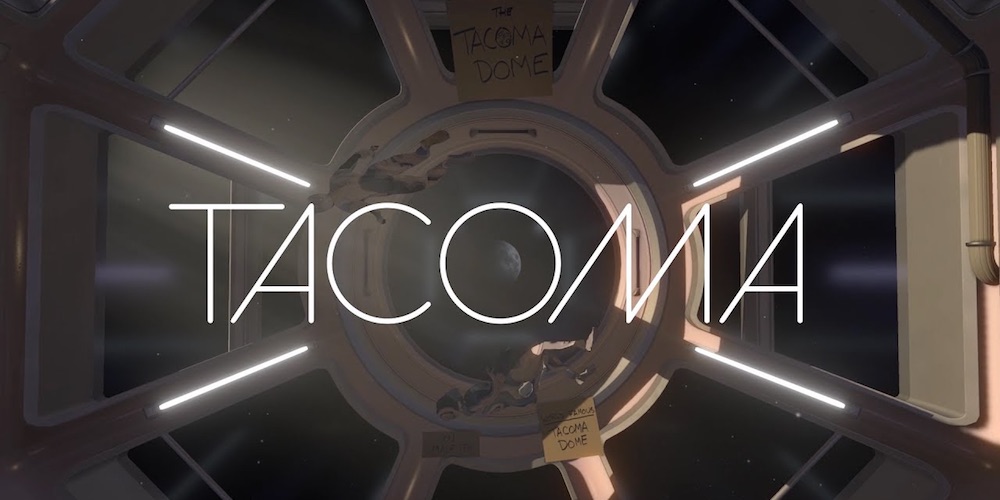
While there is a sizeable portion of the gaming population who seemingly dislike “walking simulator” type games, I’ve always liked them for the storytelling and relatively short length they offer that make them a perfect match for beer and rainy Saturday nights. Gone Home, by The Fullbright Company, was one such title to pioneer this type of game in 2013. With the whole game set in a single empty (and large) Oregon house in 1995 as a young woman returns from overseas travels, puzzles and action were replaced with nothing but exploration and sombre narrative. It was impactful, to say the least, and likely affected you emotionally, even if you consider your feeling-centre to be made of stainless steel.
This year, The Fullbright Company have followed up Gone Home with Tacoma – however, the old, empty house in the mid-nineties has been replaced with a space station in the late 2080s. The gameplay largely remains the same, though, as the goal is to search every nook and cranny as the storyline (and all the side plots) gradually reveal themselves. While the gameplay is quite simplistic – not graduating far past walking and picking up/examining items – it’s the in-depth character development, setting and ongoing mystery that makes Tacoma enjoyable to play.
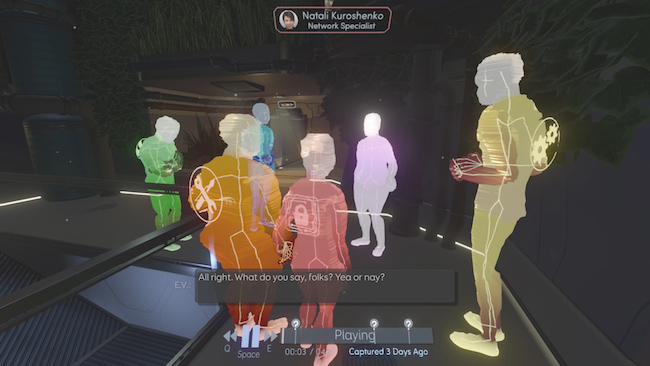
The mystery of the story and setting is an important factor to note. Basically, no orientation is given as you dock into the space station Tacoma; the entire story unfolds as you start exploring. The station is also completely devoid of life – another thing it has in common with Gone Home – although an interesting mechanic is introduced that defines it from its predecessor.
The fact that the station is empty is the reason you’re there (playing as a space-faring woman named Amitjyoti Ferrier responding to an SOS) and it’s your job is collect AR data to piece together the events that unfolded three days earlier. I don’t want to give too much away of the plot as it’s the major draw to play, but what I will tell you is that everything is pieced together by a super AI named Odin (who operates Tacoma) and AR equipment that every character does or did wear. The AR devices in-game are used to access menus, but more importantly, showcase conversations of the former crew members that can be viewed at your leisure in 3D space. Each crew member is represented as a colourful silhouette, and you can watch in real-time as their recorded conversations take place and their associated movements around the room as they do so.

Additionally, if they bring up their own AR menu, you can pause the event and look at what they were viewing at the time if it’s not corrupted data – another aspect that will appear continuously. What makes this mechanic cool is that while the conversation might start as a group, individuals will eventually split off and do their own thing. It’s here you can then chose someone to follow and focus on, and once you’ve viewed all there is to see with someone you can rewind the event and follow another conversation that happened at the same time elsewhere. Some may tire of constantly rewinding each event to catch everything that occurred in that timeline, but I found viewing all the sub plots simultaneously to be a very unique form of storytelling.
Tacoma is quite the graphical upgrade compared to Gone Home including pleasant looking shading, lighting and texturing. It’s especially fun picking up all the random objects scattered around and examining them too; some of which giving clues to the larger world beyond the Tacoma space station. I can also happily inform you from personal experience that it runs well on modest hardware. My rig from 2011 (which was overspec’d for the time, I swear) ran it fine on full settings without much chugging. Otherwise, it’s also available on Xbox One.
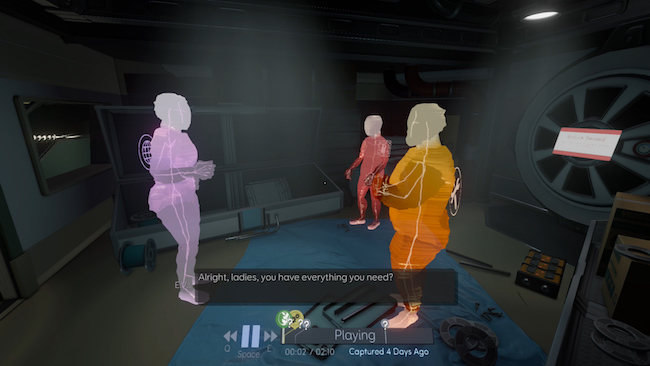
What’s disappointing, however, (although not entirely unexpected) is the length. While no different to counterparts in the genre, Tacoma runs at just three hours. There are a lot of players who won’t mind – it’s enjoyable to play something intensely story driven in an evening after all – but others may find the price tag of $20 a bit hard to swallow for such a short game.
I also had an issue with the pacing of the narrative. While the story is excellent, the mystery that made it so intriguing was elongated compared to when it hit its crescendo. The ending was pleasantly unexpected, yes. However, the period of “shit getting real” after the build-up was disappointingly short and abrupt. I guess a fair balance is difficult to achieve in only three hours, but as a very similar thing happened in Gone Home, it’s evident that it’s an area that Fullbright needs to address.
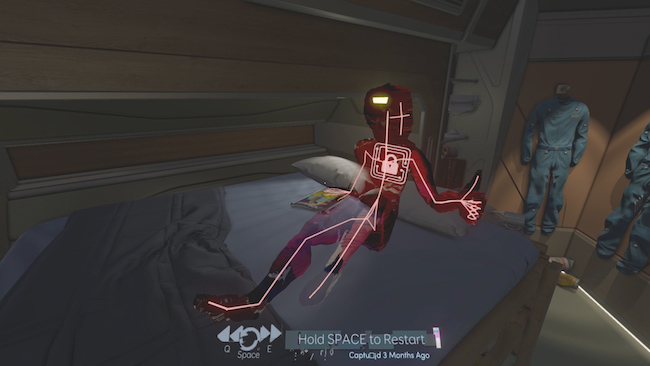
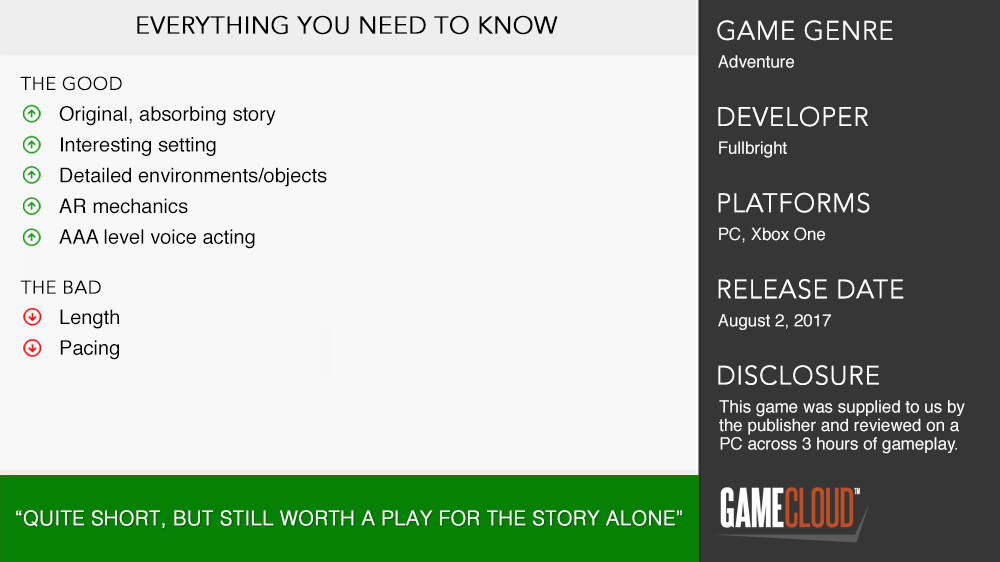
Tacoma offers many themes that are not widespread yet but is a probable snapshot of the near-future. The AR technology is cool, yes, but what really peaked my interest are the implications and morality of using super artificial intelligence. If they’re as smart as a person, do they get the same rights as the average human? Obviously, that’s a question that is outside the scope of this written review, but discussion of AI by individuals much smarter than I are really starting to ramp up (notably Elon Musk) and Tacoma hits the nail on the head with its relevance. That’s not all either; I haven’t even delved that far into the concept of humans living long term in space that Tacoma touches on. I can imagine that the price, length and pacing issues may annoy some, but otherwise, Tacoma is well worth a play for exploring these issues alone.











